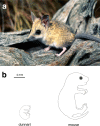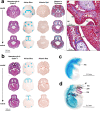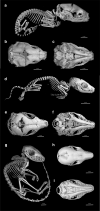Postnatal development in a marsupial model, the fat-tailed dunnart (Sminthopsis crassicaudata; Dasyuromorphia: Dasyuridae)
- PMID: 34475507
- PMCID: PMC8413461
- DOI: 10.1038/s42003-021-02506-2
Postnatal development in a marsupial model, the fat-tailed dunnart (Sminthopsis crassicaudata; Dasyuromorphia: Dasyuridae)
Abstract
Marsupials exhibit unique biological features that provide fascinating insights into many aspects of mammalian development. These include their distinctive mode of reproduction, altricial stage at birth, and the associated heterochrony that is required for their crawl to the pouch and teat attachment. Marsupials are also an invaluable resource for mammalian comparative biology, forming a distinct lineage from the extant placental and egg-laying monotreme mammals. Despite their unique biology, marsupial resources are lagging behind those available for placentals. The fat-tailed dunnart (Sminthopsis crassicaudata) is a laboratory based marsupial model, with simple and robust husbandry requirements and a short reproductive cycle making it amenable to experimental manipulations. Here we present a detailed staging series for the fat-tailed dunnart, focusing on their accelerated development of the forelimbs and jaws. This study provides the first skeletal developmental series on S. crassicaudata and provides a fundamental resource for future studies exploring mammalian diversification, development and evolution.
© 2021. The Author(s).
Conflict of interest statement
The authors declare no competing interests.
Figures








References
-
- Tyndale-Biscoe H, Renfree M. Reproductive physiology of marsupials. Cambridge: Cambridge University Press; 1987.
-
- Tyndale-Biscoe CH. Life of Marsupials. Collingwood, Victoria: CSIRO Publishing; 2005.
Publication types
MeSH terms
LinkOut - more resources
Full Text Sources

